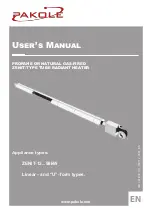
33
en
1. Remove the battery. See “Removing the Battery”.
2. Place the battery in a well ventilated area on a level sur-
face.
3. Using distilled water, refill the cells as required to cover
the cell plates.
4. With the cell caps removed, connect the battery charger
to the battery terminals: red to positive (+) terminal and
black to negative (-) terminal.
5. Slow charge the battery at 1 amp for 10 hours.
6. Reinstall the battery. See “Removing the Battery”.
7. If the battery will not accept a charge or is partially
charged after 10 hours of charging at 1 amp, replace with
a new battery.
Draining The Optional Fluid
Containment System (FCS)
Some models are equipped with a sealed fluid containment
system, designed to catch fuel, oil, or coolant spills. It can
hold a minimum of 110% of all onboard fluids/liquids. Should
a spill occur:
1. Position a suitable container beneath any of the four fluid
containment drains (A, Figure 49), located beneath the
unit toward the rear. See also ‘Features and Controls’.
2. Remove the fluid containment drain plug(s). After the
fluid has been drained, reinstall the drain plug(s).
NOTE: Apply a small amount of thread sealant onto the
drain plug threads prior to reinstalling.
3. Dispose of the fluid properly in accordance with EPA or
other governmental guidelines.
Figure 49
A
A
Specifications
NOTE: Refer to the Engine Operator’s Manual or the
Generator Operator’s Manual for specific engine or generator
specifications.
Dimensions
Compare Figure 50 with the table following.
Figure 50
B
A
C
D
E
F
I
G
H
Reference
Description
Inch
Millimeter
A
Overall Length
193.3
4910
B
Overall Width
80.0
2032
C
Ground To Top Of Roof
60.0
1524
D
Hitch To Centerline Of Axle
140.0
3556
E
Ground To Top Of Exhaust
73.7
1872
F
Ground Clearance
12.6
320
G
Ground To Top Of Lift Ring
64.3
1633
H
Overall Height – Top Of Vent
87.3
2217
I
Track Width
70.6
1793
Not
for
Reproduction
















































